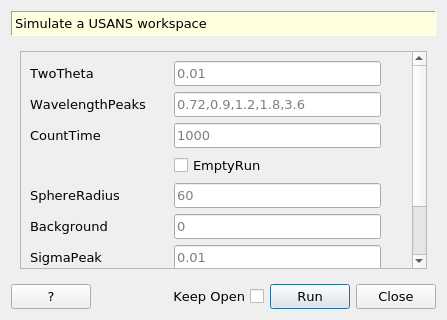\(\renewcommand\AA{\unicode{x212B}}\)
USANSSimulation v1¶

USANSSimulation dialog.¶
Summary¶
Simulate a USANS workspace
See Also¶
Properties¶
Name |
Direction |
Type |
Default |
Description |
|---|---|---|---|---|
TwoTheta |
Input |
number |
0.01 |
Scattering angle in degrees |
WavelengthPeaks |
Input |
dbl list |
0.72,0.9,1.2,1.8,3.6 |
Wavelength peaks out of the monochromator |
CountTime |
Input |
number |
1000 |
Fake count time |
EmptyRun |
Input |
boolean |
False |
If True, the run is considered an empty run |
SphereRadius |
Input |
number |
60 |
Radius for the sphere model (Angstrom) |
Background |
Input |
number |
0 |
Background |
SigmaPeak |
Input |
number |
0.01 |
Width of the wavelength peaks |
OutputWorkspace |
Output |
Mandatory |
Output workspace |
|
MonitorWorkspace |
Output |
Mandatory |
Output monitor workspace |
Description¶
Simulate a USANS workspace. This algorithm is used to test the USANS reduction during development while no real data is available.
A matrix workspace is created for a given analyzer angle. A list of wavelength peaks coming out of the monochromator can be specified. The width of those peaks can also be specified.
Both the main detector and the transmission detector are filled with compatible signals according to a dummy transmission curve.
The amplitude of the signal in the main detector is given by a sphere model.
A monitor workspace is created with a fake beam profile.
Note: This algorithm can take a very long time to execute and is of limited use for non-developers.
Categories: AlgorithmIndex | SANS
Source¶
Python: USANSSimulation.py
